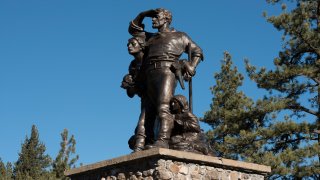
A pair of backcountry endurance athletes who became obsessed with the Donner Party spent the last seven years researching and exploring the Sierra on foot to try to pinpoint the final 90-mile (145-kilometer) route survivors of the infamous tale of cannibalism finally cut through mountain snow drifts to safety in the winter of 1846-47.
Now, four veteran ultrarunners from Northern California are setting out on snowshoes to retrace the footsteps of the pioneers who braved the worst blizzard in a century to escape over the top of what’s now called Donner Pass through the Emigrant Gap northwest of Lake Tahoe.
Fifteen members of the original 81-member Donner Party left camp west of Truckee, California, along the current Interstate 80 on Dec. 16, 1846, but only seven — two men and five women — arrived at a settlement east of Sacramento 33 days later to fetch help for dozens of others.
Historians dubbed the escape party the Forlorn Hope, a term originally used to describe military missions with no realistic chance of success.
Unlike those who left Donner Lake that day on crude snowshoes with only wool blankets, an axe and scraps of dried meat, the four extreme athletes will have modern equipment and wilderness gear on the planned five-day hike. They’ll be tracked by live GPS signals at www.forlornhope.org when they begin Wednesday — 174 years to the day after their predecessors.
Tim Twietmeyer, five-time winner of the Western States 100-mile (160-kilometer) endurance run, and Bob Crowley, president of the International Trail Running Association, have been running backcountry trails more than four decades. They’ll be joined by ultra-runners Jennifer Walker Hemmen and Elke Reimer.
“As I’ve read the account of the Forlorn Hope and then traveled in their footsteps, it has only galvanized my belief this might be the greatest endurance trek in history,” Twietmeyer said.
California
Crowley, who lives near Sacramento, became intrigued by the journey when he read a novel about the pioneers best known for eating the flesh of their dead companions to stay alive. Cowley “realized it happened right in my own backyard.”
The more he learned, the more convinced he became that cannibalism was but a footnote of a bigger story about “perseverance, passion and grit.”
Crowley said the four modern explorers hope it snows because they’re trying to recreate the experience as much as possible.
“Which we know is impossible to really do because we’ll have the latest technology, and we know where we’re going and we’ll have plenty of food,” he said in a telephone interview Monday. “But I think our mantra is, ‘Let it snow.’ The worse it gets, the happier the four of us would be.”
The Donner Party families traveled 2,000 miles (3,218 kilometers) west in a wagon train in 1846, mostly from Missouri and Illinois, to claim free land in California before the discovery of gold in what was then the Mexican Territory.
Trouble began when they took an unproven “shortcut” and were delayed in Utah and Nevada. Eighty-one men, women and children reached the Sierra in late October and were trapped in the snow before some built cabins at what’s now Donner Lake.
Since the 1980s, archaeologists and others have investigated various stretches of the Forlorn trail that begins with a 1,000 foot (304 meter) elevation climb near what’s now the I-80 corridor, but the complete route topping 7,000 feet (2,133 meters) has remained a matter of speculation.
Seven years ago, Crowley and Twietmeyer started gathering accounts from diaries and historic journals to compare and contrast various descriptions of the escape party’s daily movements during the 33-day journey that ultimately saved the lives of about 40 others.
They eventually identified at least six different theories about the route. Scouring satellite imagery and topographic maps, they set out on the ground to gather first-hand observations on each trail segment before settling on the two most likely.
Judy DePuy, longtime member of the Truckee Donner Railroad and Donner Summit historical societies, said previous efforts to identify the route relied on aerial photos and diaries that were never fact-checked on the ground.
“Doing the real recon work is worth its weight in gold,” she said.
Crowley told the Reno News & Review they are 85% sure they’ll be following in the original footsteps.
He said they embraced two major principles in their quest to establish the most authentic route — “always presume you’re wrong” and “accept nothing as the whole truth or fact.”
And they often relied on the most basic premise: hikers follow the path of least resistance and exertion while maintaining a proper bearing toward destination.
Bill Oudegeest, a founding member of the Donner Summit Historical Society, partnered with Crowley and Twietmeyer to help verify the trail. He said the cannibalism is the only thing most know about the Donner Party.
“For most people, there the story ends, leaving out the heroism and human nature fighting the elements,” he said. “There is so much more, and these four athletes want to change the narrative.”



